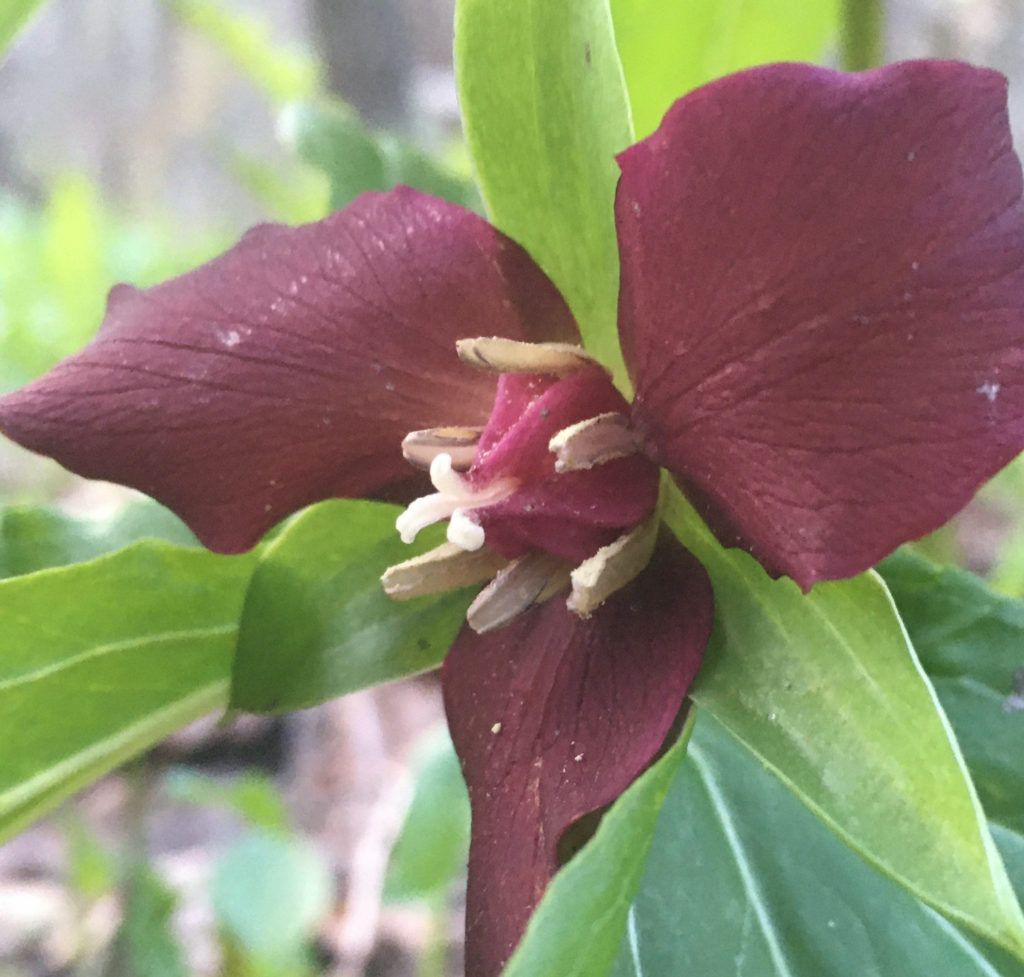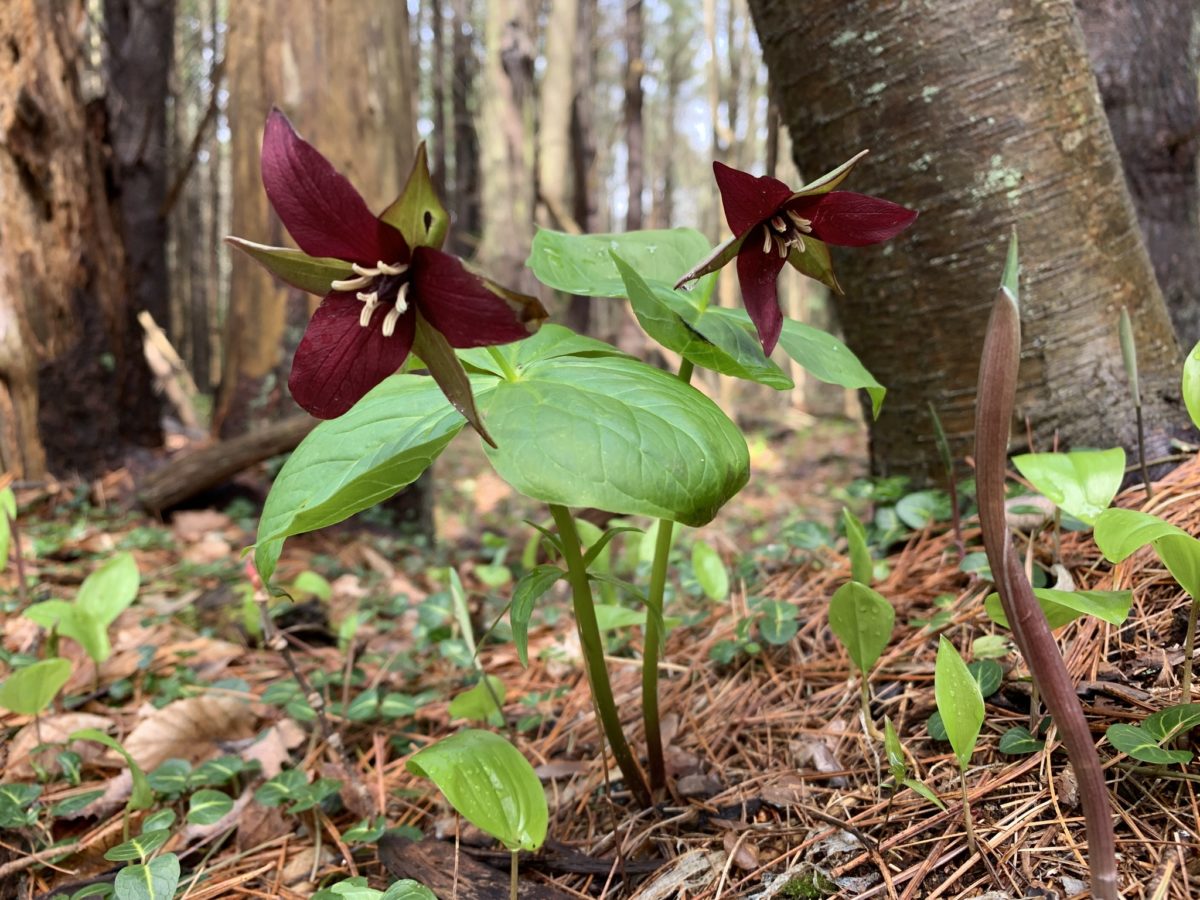It’s the most wonderful time of the year — when trilliums are in bloom! Since I can’t get out in the woods much right now, instead have some completely useless facts about red trilliums.
Red trillium (Trillium erectum), like all trilliums, is a monocot, meaning it arises from a seed with a single cotyledon or seed leaf. Most plants are dicots, which have seeds with two cotyledons, so this makes trilliums a little bit special. At least, when I was a young teenager, I thought monocots were pretty cool.
That probably says something about cool a teenager I was not.
Therefore trilliums are class Liliopsida (monocot)*, and order Liliales, both of which are fancy ways of saying, with varying degrees of freedom… “it’s kind of like a lily.” But rather than being a member of family Liliaceae, it’s a member of the bunchflower family, Melanthiaceae, which are described as — get this — “lilioid monocots.”
That is… “it’s kind of like a lily.” Boy, botanists are good at naming things.
* Botanists will argue if monocots are a class or a clade. A clade is a category distinct from a taxa, based on a system of classification that is more focused on evolutionary relationships between plants than taxonomy traditionally is. (Except taxonomy is becoming more evolutionary-focused… okay, let’s not go into the whole weird conversation I had when I asked ChatGPT to explain cladistics to me). But for the purposes of this post — where I will never mention cladistics again! — let’s go with what iNaturalist says, which is that class Liliopsida = monocots.
Also grasses are in class Liliopsida, too. LOOK I DON’T MAKE THE RULES.
Have I lost you yet? No? Oh good. Let’s get into the actual dumb plant facts. Some these are about trilliums as a genus; some are more specific to red trilliums.
- Every aerial structure in trilliums — leaves, sepals, petals, reproductive structures — comes in multiples of threes. Hence the “tri” in the name.
… Wait, I just realized… it’s basically “tri-lilium,” isn’t it? Botanists, you bastards. - As a super cool teenager (already established), I typed up the Mary Oliver poem “Trilliums” for a school assignment. (Which is technically about T. grandiflorum, the white trillium). In the process I discovered… each line is indented by three spaces. Mary Oliver, you magnificent bastard, I read your book! (Dream Work, New York: Atlantic Monthly Press, 1986)
- T. erectum has a funky-looking six-lobed ovary with six stamens arranged around it. (See picture below). Again: multiples of three.

- This makes the red trillium monoecious, meaning it has both male and female reproductive structures on the same plant. (Hubba hubba). And since there’s only a single influorescence (a fancy way of saying “flower”), it is also a “perfect” or bisexual flower, having both pistils and stamens.
Thank you, botanists, for acknowledging the perfection of bisexuals. I’m ready for your hot take on elf-earred disaster bisexuals; call me 🤙
- The flower of red trillium is malodorous, attracting carrion flies and beetles as pollinators! This is why one of the common names is “stinking benjamin.”
- The fruit of red trillium is a berry. This means it a multitude of seeds surrounded by a fleshy pericarp (pulp). Just like a tomato, in fact!
… do not eat the trillium. - Unlike a tomato, however, the fruit of the red trillium has (surprise surprise) threefold symmetry in cross-section.
- The seeds of red trillium are dispersed primarily by ants, who find the fleshy pulp of the fruit delicious, and throw out its numerous seeds in their middens.
- Red trilliums, being bisexual, can self-pollinate (wait, you can’t?) However, they set seed more reliably when cross-pollinated. It’s hypothesized this is because it has a “self-incompatibility” mechanism, which a number of different plants have as an adaptation. Presumably this encourages genetic diversity?
Considering plants can reproduce asexually, they already have a lot to answer for when it comes to genetic diversity
- Trilliums are morphologically “scapes,” meaning they produce no true leaves or stems above ground. (Think of a garlic scape… GODDAMNIT I ALREADY SAID DO NOT EAT THE TRILLIUM). The stem is just an extension of the rhizome, and the “leaves” are actual flower bracts. However, these bracts photosynthesize, and have the same internal and external structure as leaves, so for all intents and purposes… they’re leaves.
That’s all the dumb (red) trillium facts I’ve got, nature fiends. It’s breakfast time as I write this, so maybe I’ll go have a nice omelet now, with garlic and tomatoes AND DEFINITELY NOT TRILLIUMS.
Featured image: two red trilliums (Trillium erectum). Taken by Lise Fracalossi, May 1 2020, in Lane Conservation Area in Lunenburg, MA.
